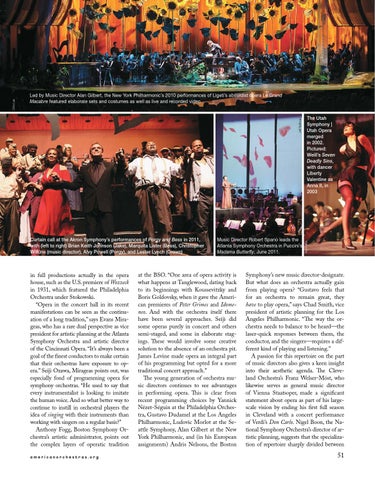Jeff Roffman
Curtain call at the Akron Symphony’s performances of Porgy and Bess in 2011, with (left to right) Brian Keith Johnson (Jake), Marquita Lister (Bess), Christopher Wilkins (music director), Alvy Powell (Porgy), and Lester Lynch (Crown)
in full productions actually in the opera house, such as the U.S. premiere of Wozzeck in 1931, which featured the Philadelphia Orchestra under Stokowski. “Opera in the concert hall in its recent manifestations can be seen as the continuation of a long tradition,” says Evans Mirageas, who has a rare dual perspective as vice president for artistic planning at the Atlanta Symphony Orchestra and artistic director of the Cincinnati Opera. “It’s always been a goal of the finest conductors to make certain that their orchestras have exposure to opera.” Seiji Ozawa, Mirageas points out, was especially fond of programming opera for symphony orchestras. “He used to say that every instrumentalist is looking to imitate the human voice. And so what better way to continue to instill in orchestral players the idea of singing with their instruments than working with singers on a regular basis?” Anthony Fogg, Boston Symphony Orchestra’s artistic administrator, points out the complex layers of operatic tradition americanorchestras.org
Music Director Robert Spano leads the Atlanta Symphony Orchestra in Puccini’s Madama Butterfly, June 2011.
at the BSO. “One area of opera activity is what happens at Tanglewood, dating back to its beginnings with Koussevitzky and Boris Goldovsky, when it gave the American premieres of Peter Grimes and Idomeneo. And with the orchestra itself there have been several approaches. Seiji did some operas purely in concert and others semi-staged, and some in elaborate stagings. These would involve some creative solution to the absence of an orchestra pit. James Levine made opera an integral part of his programming but opted for a more traditional concert approach.” The young generation of orchestra music directors continues to see advantages in performing opera. This is clear from recent programming choices by Yannick Nézet-Séguin at the Philadelphia Orchestra, Gustavo Dudamel at the Los Angeles Philharmonic, Ludovic Morlot at the Seattle Symphony, Alan Gilbert at the New York Philharmonic, and (in his European assignments) Andris Nelsons, the Boston
The Utah Symphony | Utah Opera merged in 2002. Pictured: Weill’s Seven Deadly Sins, with dancer Liberty Valentine as Anna II, in 2003
Kent Miles
Chris Lee
Led by Music Director Alan Gilbert, the New York Philharmonic’s 2010 performances of Ligeti’s absurdist opera Le Grand Macabre featured elaborate sets and costumes as well as live and recorded video.
Symphony’s new music director-designate. But what does an orchestra actually gain from playing opera? “Gustavo feels that for an orchestra to remain great, they have to play opera,” says Chad Smith, vice president of artistic planning for the Los Angeles Philharmonic. “The way the orchestra needs to balance to be heard—the laser-quick responses between them, the conductor, and the singers—requires a different kind of playing and listening.” A passion for this repertoire on the part of music directors also gives a keen insight into their aesthetic agenda. The Cleveland Orchestra’s Franz Welser-Möst, who likewise serves as general music director of Vienna Staatsoper, made a significant statement about opera as part of his largescale vision by ending his first full season in Cleveland with a concert performance of Verdi’s Don Carlo. Nigel Boon, the National Symphony Orchestra’s director of artistic planning, suggests that the specialization of repertoire sharply divided between
51
